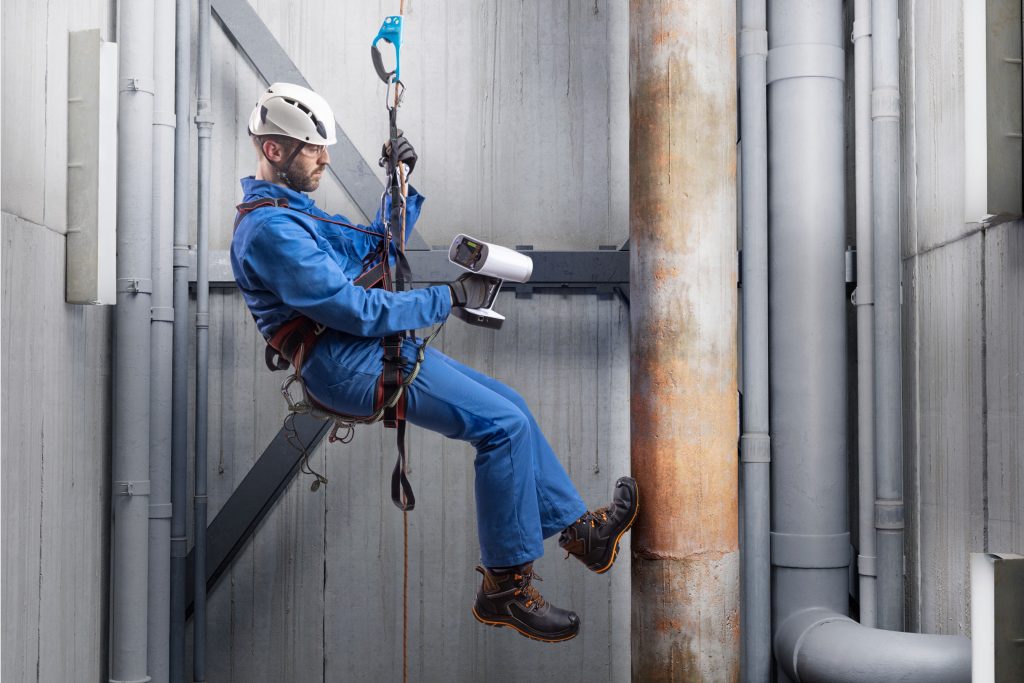Luxembourg-based 3D scanner manufacturer Artec 3D has launched a new and improved version of its Artec Leo system.
Featuring the same built-in touchscreen and wireless functionality as its predecessor, but twice the power, the firm says that its 2022 Artec Leo is capable of providing users with “improved vibrant color capture” and “guaranteed accuracy.”
Powered by an upgraded NVIDIA Jetson TX2 processor, the unit also has a huge 160,000 cm3 capture zone, meaning that it can scan objects over 200cm in size, ranging from auto-parts to people and spaces, potentially lending it CSI suitability.
“The Artec Leo was the industry’s first AI-powered wireless 3D scanner, making it truly revolutionary,” said Artyom Yukhin, President and CEO of Artec 3D. “We’ve [now] taken that a step further to ensure anyone using the 2022 Artec Leo feels confident that they’re getting top-tier, professional results with guaranteed accuracy and sharper data.”
Aiming for accessible performance
Since being founded in 2007, Artec 3D has set out on a self-proclaimed mission to develop the “simplest possible 3D scanning technology for achieving professional results.” In doing so, the company has established a device portfolio of all shapes, sizes and capabilities, with the feature sets necessary to address everything from medical to design applications.
With its most recent launch prior to the new Artec Leo, the Artec Micro, the firm introduced an automated desktop scanner, ideal for achieving industrial-quality scans of small-sized objects. Artec 3D’s latest scanner, on the other hand, is designed to address an entirely different market. Built for portability and boosted by a powerful new processor, the 2022 Artec Leo is better suited to scanning at scale.
The company has promoted its updated device as a means of capturing parts like castings, gearboxes and ship propellers, as well as wider areas, and there’s certainly a precedent for its scanners being used in this way. Late last year, Artec 3D revealed that Origin Forensics had begun deploying the previous Leo to create digital twins of cars, as a means of carrying out traffic collision investigations.
Similarly, on the British automotive TV show Car SOS, Central Scanning has previously utilized the Artec Space Spider to scan the center console of a Ford Cortina, capturing data that was later used to 3D print a replica. Recently, Artec 3D’s technologies have also found sporting applications, with Vorteq using the Artec Leo to create aerodynamic cycling skinsuits for athletes at the Tokyo Olympics.

The upgraded 2022 Artec Leo
Compared to its predecessor, there can be no doubt that the headline addition to the 2022 Artec Leo is its enhanced TX2 processor. With two more 2GHz cores, and a heterogeneous multi-processor architecture, the chipset not only makes Artec 3D’s latest scanner twice as fast as before, but it does so while operating on less than 7.5 watts of power, making it more energy-efficient too.
The module’s upgraded eMMC 5.1 32GB onboard memory and 59.7 GB/s data transfer speed, also serve to enhance the new Artec Leo’s AI-driven functionality, including key enablers such as its GPU performance and memory bandwidth.
“The TX2 allows us to implement more AI-powered algorithms and processes directly on board the scanner,” explains Gleb Gusev, CTO of Artec 3D. “With this technology, users will experience even faster and more accurate results, and an even more intuitive automated workflow.”
On the precision front, the 2022 Artec Leo boasts a point accuracy of up to 0.1mm, and thanks to its new reconstruction algorithm, Artec 3D says that its SD-captured images are now “sharper, cleaner and more detailed.” By contrast, when operated in HD mode, the device is now said to be capable of doubling the resolution of scan data, making obscured areas easier to capture than ever before.
Artec 3D has also announced that the new Artec Leo will come with a texture optimization algorithm that auto-adjusts a texture’s brightness when scanned close up, yielding more evenly-lit models, in addition to auto-temperature control, preventing its accuracy from being interfered with by overheating, and a calibration card for environmental tuning, but this feature won’t be launched until April 2022.
Elsewhere, the 2022 Artec Leo retains the same wireless flexibility and 5.5” display as its predecessor, making it as easy to pick up and use as ever. To take this a step further, Artec 3D has also continued to play on the AI capabilities of its system, introducing more rapid and intuitive scanning modes, as well as a new interface that’s available in English, Chinese, French, German, Japanese and Spanish.

Technical specifications and pricing
Below are the technical specifications for the 2022 Artec Leo 3D scanner. The device is available to order now with pricing available on request.
| 3D Light Source | VCSEL |
| 2D Light Source | White 12 LED Array |
| 3D Point Accuracy | Up to 0.1mm |
| 3D Resolution | Up to 0.2mm |
| Texture Resolution | 2.3 mp |
| Working Distance | 0.35 – 1.2 m |
| Data Acquisition Speed | up to 35 mln points/s |
| Internal Hard Drive | 512 GB SSD |
| Dimensions | 231 x 162 x 230 mm |
| Weight | 2.6 kg |
To stay up to date with the latest 3D printing news, don’t forget to subscribe to the 3D Printing Industry newsletter or follow us on Twitter or liking our page on Facebook.
For a deeper dive into additive manufacturing, you can now subscribe to our Youtube channel, featuring discussion, debriefs, and shots of 3D printing in-action.
Are you looking for a job in the additive manufacturing industry? Visit 3D Printing Jobs for a selection of roles in the industry.
Featured image shows a designer operating Artec 3D’s 2022 Artec Leo 3D scanner. Photo via Artec 3D.


